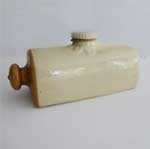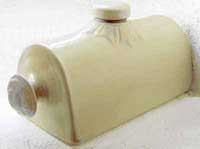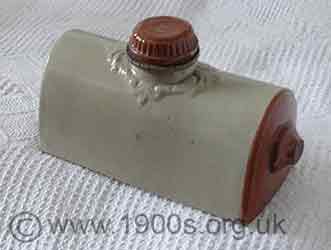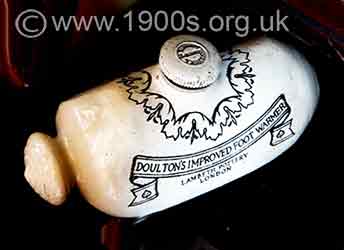Stone/ceramic hot water bottles and warming pans for warming beds

Stoneware hot water bottles, hot bricks and warming pans are among the many devices used in the past to warm a bed. More recently rubber hot water bottles took over and more recently still, as have heat packs. This page describes these devices and considers their safety issues.
____
By the webmaster based on firsthand recollections, contributions from others and additional research
What stoneware is
Stoneware is a particular type of clay or ceramic fired at a particularly high temperature as is pottery and glazed so that it is non-porous and resembles polished stone. In fact stoneware was often just called 'stone'. It is always heavy. The glaze is a thin layer of any glass-like material. Stoneward is usually beige or white.
Stoneware hot waters
Stone hot water bottles were much heavier than modern ones, particularly when filled with water.

A basic stoneware hot water bottle often just called a 'stone' hot water bottle
As a child in the 1940s, there was only one hot water bottle in the house, and it was stoneware. I can assure you that by today's standards it was far from ideal.
Our stone hot water bottle was basic, i.e. all the same all-over colour and essentially undecorated. There were other designs. The first of the following photos shows the use of coloured clay and the second shows a patterned and printed design. Interestingly, the print reads that it doubles as a foot warmer. Certainly feet could easily rest either side of of the central stopper.

Stone hot water bottle with coloured knobs

Stone hot water bottle, patterned and printed
How stoneware hot water bottles were used
Stone hot water bottles could only realistically be used for heating beds, not parts of the body, other than feet. They had been around since the early 1900s and probably before.
To use a stone hot water bottle, it was filled with hot or boiling water through the neck at the top which was screwed closed afterwards. Then it was dried with a cloth if any water had escaped, and then it was put between bedsheets to warm the bed.
Use for stone hot water bottles with pets
contributed by Laerke Pickering Thomase from personal experience
I volunteer in an RSPCA charity shop in Swindon where we recently had a collection of donated stone hot water bottles. I took one home and my house rabbits like snuggling up next to it when I fill it with ice water during the hot weather! These bottles are much more efficient than the usually recommended frozen plastic type, as they keep cool for a lot longer.
Shape, and the purpose of the rounded knob on stone hot water bottles
These stoneware hot water bottles were shaped so that as much of the bed as possible could be warmed. The idea was to stand them upright in bed, on their small flat end so that the sheets and blankets formed a tent-like structure over them. The peak of the 'tent' was the special feature of the rounded knob opposite the flat end, which also served as a carrying handle.

Stone hot water bottle showing the filling opening and the carrying knob
Used this way, the hot water bottle was supposed to heat more of the bed - but it was an unstable arrangement and the 'tent' would have been quite small, as even with the knob to give extra height, the arrangement was not very tall. I suspect that most people used the bottle on its larger flat surface, as shown in the photographs.
Health and safety concerns
Our stone hot water bottle was only used on very rare occasions. Probably my mother was scared, with some justification, that it would crack or leak, which would burn someone and make the bed wet.
However, she never gave those reasons. It was always - so she said - that it was healthy to get into a cold bed and warm it up oneself. As a child I believed her, although in winter it was extremely cold in bed, as no fire was ever lit in the bedrooms and the windows were single glazed. It was not uncommon to wake up to ice on the insides of the windows from frozen condensation.
Bricks: a safer useful and alternative?
contributed by Reg (surname supplied), childhood recollections
Although we did have a stone hot water bottle in my house in the 1940s, one wasn't enough for everyone's bed. So my mother would put a builders brick into the oven to heat and then wrap it, first in a newspaper and then an old jumper. This went into my bed. The brick seemed to stay hot for a long time and couldn't leak, so worked well. The newspaper would lag the brick so stopping it burning skin while also keeping any dirty brick dust away from the clean sheets. Incidentally, all but the very poorest families had daily newspapers in those days.
Warming pans as alternatives to stoneware hot water bottles
Warming pans were used in Victorian and Edwardian times as a way to warm beds. They were like a large flat saucepan with a firmly fitting lid and a long wood handle as seen below. They relied, not on hot water, but on hot embers from coal fires. They went out of use with the demise of old-style coal fired kitchen ranges with their ovens of hot coals.

Warming pan or bedwarmer, a copper container for hot coals with a lid on a long handle
To warm the beds, the lid of the pan was opened and a few hot coals from the fire were put inside. The pan was firmly closed and taken into the bedrooms. The long handle kept it cool to the touch although the pan itself was hot. The hot pan was then slid between the bedsheets and moved round over them, so warming them. It was never left in the bed as the embers were very hot and would have scorched the sheets.
It was typically a maid's task to warm the beds this way, which is why it was popular in Victorian grand houses. By the 1940s, I never knew of any warming pan still in use.
Rubber hot water bottles
As I write, rubber is most commonly used for hot water bottles because it is easy to fill from the kettle and reasonably flexible to hold against any part of the body. However it can burn unless wrapped in a towel or special cover and with time, it will almost certainly leak and need replacing.
Heat packs
A heat pack (also known as a wheat bag or pack) is usually a fabric bag filled with wheat or other grain and heated in the microwave. It has the advantage of being soft and squiggy so that it can fit to the body's contours and so be used anywhere there to warm and relieve pain. Also it cannot leak hot water. The disadvantage is that it can overheat in the microwave and so cause burns.
| sources | webmaster | contact |
Text and images are copyright
If you can add anything to this page or provide a photo, please contact me.



